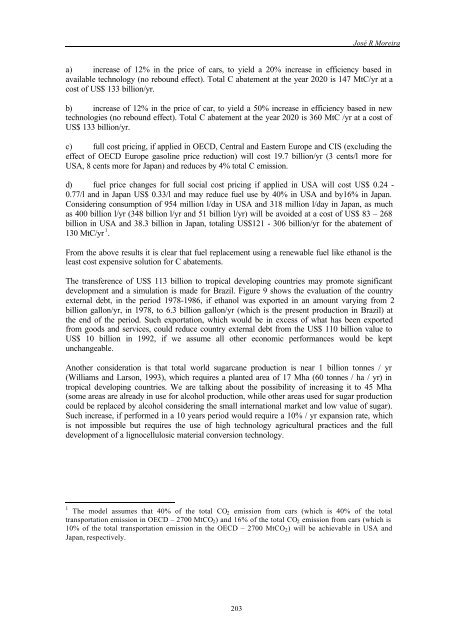sectoral economic costs and benefits of ghg mitigation - IPCC
sectoral economic costs and benefits of ghg mitigation - IPCC
sectoral economic costs and benefits of ghg mitigation - IPCC
You also want an ePaper? Increase the reach of your titles
YUMPU automatically turns print PDFs into web optimized ePapers that Google loves.
José R Moreira<br />
a) increase <strong>of</strong> 12% in the price <strong>of</strong> cars, to yield a 20% increase in efficiency based in<br />
available technology (no rebound effect). Total C abatement at the year 2020 is 147 MtC/yr at a<br />
cost <strong>of</strong> US$ 133 billion/yr.<br />
b) increase <strong>of</strong> 12% in the price <strong>of</strong> car, to yield a 50% increase in efficiency based in new<br />
technologies (no rebound effect). Total C abatement at the year 2020 is 360 MtC /yr at a cost <strong>of</strong><br />
US$ 133 billion/yr.<br />
c) full cost pricing, if applied in OECD, Central <strong>and</strong> Eastern Europe <strong>and</strong> CIS (excluding the<br />
effect <strong>of</strong> OECD Europe gasoline price reduction) will cost 19.7 billion/yr (3 cents/l more for<br />
USA, 8 cents more for Japan) <strong>and</strong> reduces by 4% total C emission.<br />
d) fuel price changes for full social cost pricing if applied in USA will cost US$ 0.24 -<br />
0.77/l <strong>and</strong> in Japan US$ 0.33/l <strong>and</strong> may reduce fuel use by 40% in USA <strong>and</strong> by16% in Japan.<br />
Considering consumption <strong>of</strong> 954 million l/day in USA <strong>and</strong> 318 million l/day in Japan, as much<br />
as 400 billion l/yr (348 billion l/yr <strong>and</strong> 51 billion l/yr) will be avoided at a cost <strong>of</strong> US$ 83 – 268<br />
billion in USA <strong>and</strong> 38.3 billion in Japan, totaling US$121 - 306 billion/yr for the abatement <strong>of</strong><br />
130 MtC/yr 1 .<br />
From the above results it is clear that fuel replacement using a renewable fuel like ethanol is the<br />
least cost expensive solution for C abatements.<br />
The transference <strong>of</strong> US$ 113 billion to tropical developing countries may promote significant<br />
development <strong>and</strong> a simulation is made for Brazil. Figure 9 shows the evaluation <strong>of</strong> the country<br />
external debt, in the period 1978-1986, if ethanol was exported in an amount varying from 2<br />
billion gallon/yr, in 1978, to 6.3 billion gallon/yr (which is the present production in Brazil) at<br />
the end <strong>of</strong> the period. Such exportation, which would be in excess <strong>of</strong> what has been exported<br />
from goods <strong>and</strong> services, could reduce country external debt from the US$ 110 billion value to<br />
US$ 10 billion in 1992, if we assume all other <strong>economic</strong> performances would be kept<br />
unchangeable.<br />
Another consideration is that total world sugarcane production is near 1 billion tonnes / yr<br />
(Williams <strong>and</strong> Larson, 1993), which requires a planted area <strong>of</strong> 17 Mha (60 tonnes / ha / yr) in<br />
tropical developing countries. We are talking about the possibility <strong>of</strong> increasing it to 45 Mha<br />
(some areas are already in use for alcohol production, while other areas used for sugar production<br />
could be replaced by alcohol considering the small international market <strong>and</strong> low value <strong>of</strong> sugar).<br />
Such increase, if performed in a 10 years period would require a 10% / yr expansion rate, which<br />
is not impossible but requires the use <strong>of</strong> high technology agricultural practices <strong>and</strong> the full<br />
development <strong>of</strong> a lignocellulosic material conversion technology.<br />
1 The model assumes that 40% <strong>of</strong> the total CO 2 emission from cars (which is 40% <strong>of</strong> the total<br />
transportation emission in OECD – 2700 MtCO 2 ) <strong>and</strong> 16% <strong>of</strong> the total CO 2 emission from cars (which is<br />
10% <strong>of</strong> the total transportation emission in the OECD – 2700 MtCO 2 ) will be achievable in USA <strong>and</strong><br />
Japan, respectively.<br />
203
















